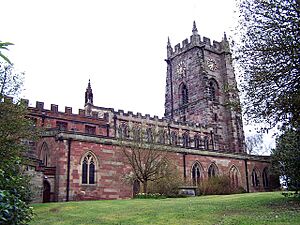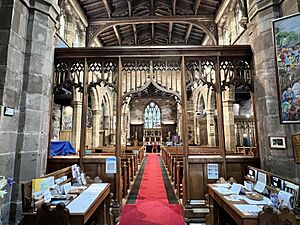St Mary's Church, Market Drayton facts for kids
St Mary's Church is a beautiful old church in Market Drayton. It sits high up on a red sandstone rock, looking over the River Tern. This church is very special. It is listed as a Grade II* building. This means it is an important historic place in England.
Contents
History of St Mary's Church
The story of St Mary's Church goes back a long time. In 1086, a very old book called the Domesday Book mentioned a priest in Drayton. This suggests there was likely a wooden church here even before that.
Building the Stone Church
The stone church you see today was built around 1150. It was made in the Norman style. This style is known for its thick walls and round arches.
Market Moves and Changes
For a while, a weekly market was held in the churchyard. But in 1201, Pope Innocent III said this should stop. So, the market moved a short distance away. It is still held in that spot today.
In the 1320s, the church had some big building projects. Later, in the 1700s, more parts were added. These included special seating areas called box pews. However, these additions were removed in the 1880s.
Recent Events at the Church
On June 9, 2025, there was a fire at the church. It started near the main west door. The fire damaged part of the door. It also filled the inside of the church with smoke.
Inside St Mary's Church
When you go inside St Mary's Church, you will see many interesting things.
Beautiful Stained Glass Windows
The church has some amazing stained glass windows. The large window at the west end shows Queen Victoria. It was made by artists named Shrigley and Hunt.
The window at the east end shows the Resurrection of Jesus. This means Jesus coming back to life. It was made by a famous artist named Charles Eamer Kempe. He also made other windows in the church. These windows show Jesus healing the blind near Jericho. They also show him raising Lazarus from the dead. Another window shows him healing the paralytic at Bethesda. In another part of the church, you can see windows showing the flight into Egypt. There is also one showing the Presentation of Jesus at the Temple.
Memorials to the Corbet Family
The Corbet family was very important to the church. They owned the land nearby. You can find several memorials to them inside. One is a brass plaque with the Corbet coat of arms. It remembers Rowland Corbet, who passed away in 1560.
Above this is a memorial to Dame Alice Corbet. She passed away in 1682. She had twenty children! Her husband, Sir John Corbet, was buried here in 1662. He was a well-known politician.
The Church Organ
The church had its first organ in 1805. This was replaced after 1866. The current organ used to block the view of the altar. But now, its pipes have been moved. The part where the organist plays is now on the north side.
Outside St Mary's Church
The outside of the church was mostly rebuilt in the late 1800s. It is made of red sandstone. The tower also has some grey sandstone.
The Tower and Bells
The church tower has strong supports called buttresses. It also has battlements at the top. These were added in the 1500s. The pointy parts on the corners are called crocketed pinnacles. They were added in the 1800s.
St Mary's Church has eight bells. The oldest bell was made in 1700. The largest bell weighs about 889 kilograms. The smallest bell weighs about 279 kilograms.
The Old West Door
The main west door has a special arch. This Norman arch is the only part left from the first stone church. It is very old. It was built in the 1100s.
In the early 1300s, this doorway became part of the church's structure. Above the door is a large west window. It has fancy stone patterns. These patterns were popular during that time.
There is a famous story about Robert Clive. He was a very important person in history. He went to school nearby in the 1730s. People say he once climbed out onto one of the tower's carved gargoyles!
Buntingsdale Chapel
The Buntingsdale Chapel is a special part of the church. It has always been connected to the owners of Buntingsdale Hall. These families included the Bulkleys and the Mackworths. Part of the chapel is now a room for the choir. This room is above old family burial vaults.
The chapel also has paintings by an artist named Parry. These paintings were done in the late 1900s. One painting is called Man's search for God. The other side shows Seasons of Faith.
War Memorials
St Mary's Church has a special area called the "Chapel of the Resurrection." This side chapel was made to remember local people. These people died in the two big world wars of the 1900s.
Inside, there is a large brass memorial. It was put there after the First World War. There are also special cushions called kneelers. They have badges of the army groups. These groups are where the remembered soldiers served.
Near the main altar, there are plaques for Major Charles Egerton Hugh Harding. He passed away in 1917. There is also one for Second Lieutenant John Alberic Everard Upton. He was killed in the Battle of the Somme in 1916. On the south wall, there is a plaque for Lieutenant Charles Henry Lycett Warren. He was killed in the Siege of Lucknow in 1857.
See also
- Grade II* listed buildings in Shropshire Council (A–G)
- Listed buildings in Market Drayton



